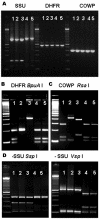Mixed Cryptosporidium infections and HIV
- PMID: 16707069
- PMCID: PMC3373040
- DOI: 10.3201/eid1206.060015
Mixed Cryptosporidium infections and HIV
Abstract
Mixed Cryptosporidium infections were detected in 7 of 21 patients with a diagnosis of rare Cryptosporidium canis or C. felis infections; 6 patients were infected with 2 Cryptosporidium spp. and 1 patient with 3 species. Mixed infections may occur more frequently than previously believed and should be considered when assessing cryptosporidiosis.
Figures

References
-
- Gile M, Warhurst DC, Webster KA, West DM, Marshall JA. A multiplex allele specific polymerase chain reaction (MAS-PCR) on the dihydrofolate reductase gene for the detection of Cryptosporidium parvum genotypes 1 and 2. Parasitology. 2002;125:35–44. - PubMed
-
- McLauchlin J, Amar C, Pedraza-Diaz S, Nichols GL. Molecular epidemiological analysis of Cryptosporidium spp. in the United Kingdom: results of genotyping Cryptosporidium spp. in 1,705 fecal specimens from humans and 105 fecal specimens from livestock animals. J Clin Microbiol. 2000;38:3984–90. - PMC - PubMed
Publication types
MeSH terms
Substances
Grants and funding
LinkOut - more resources
Full Text Sources
Medical
Miscellaneous
